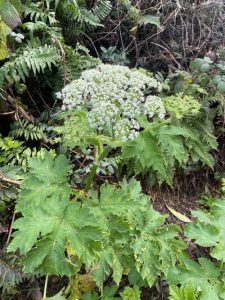Are all native plants “good”? Are all non-native plants “bad”? What do “good” and “bad” plants even mean?
There’s a lot to consider before labelling a plant as “good” or “bad”. That value judgement is no doubt contrived, and most plants are generally somewhere in-between.
So what’s the deal with native species?
Native species grow harmoniously with other species in the local ecosystem, which is considered a “good” thing. But…
Some native plants may be “good” for the local environment while still being “bad” for human health. Some native plants are poisonous, abrasive, or toxic. Cow parsnip, for example, is a toxic plant that’s native to the Sea to Sky corridor. It contains sap which causes skin to burn when exposed to sunlight. Devil’s club is another example: while it plays an important role in the local food web and the cultural practices of local Indigenous groups, its spiky stems and leaves can scratch or harm human skin.
Additionally, many native plants make “bad” garden plants because they attract bears. Most native fruit or berry-producing plants – such as salmonberry or blueberry plants – shouldn’t be planted in gardens due to the risk of attracting bears. You can read more about ‘bearsmart’ gardening in a past blog post.
Lastly, some native plants can spread fairly rapidly, despite belonging in our ecosystem. When they grow in gardens, we sometimes deem them ‘weedy’ or simply undesirable. For example, Horsetail is a native weed that is difficult to control in garden settings… and it often drives gardeners crazy!

Cow parsnip is a native species in the Sea to Sky that is toxic to humans.
And what about non-native species?
Non-native species include, but are not limited to, invasive species. Only a subset of non-native species are invasive.
Invasive species are invasive because damage their new environment, society, or economy, which is definitely a “bad” thing.
Many invasive species were introduced to the Sea to Sky region as ornamental plants because they produce pretty flowers and look “good” – but afterwards were found to have negative effects. English ivy or Scotch broom are both invasive plants originally introduced as garden ornamentals.
Other non-native plants minimally impact the environment, society, and economy, so they’re neither “good” nor “bad”. These species might not be native, but since they don’t cause any harm, they’re not considered invasive. These non-native plants are considered exotic species. An example of this could be tomato plants: while tomatoes are not native to the region, they don’t spread, form monocultures, or crowd out native plants, and they don’t impact the region’s ecosystems. Tomato plants might even be considered “good”, since they provide us with fresh tomatoes to eat!
Scotch broom might look pretty, but it is invasive and causes harm in the Sea to Sky
The verdict
Just because a plant is native to an area doesn’t mean it’s automatically “good” – whether something is “good” or “bad” is very context-dependent.
The same goes for non-native plants – generally invasive plants are “bad” but this doesn’t mean that all non-native plants “bad”. There are plenty of non-native, exotic plants that benefit humans!

